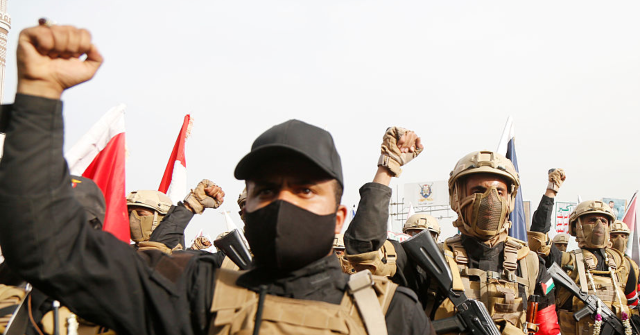Multiple reports published this week indicate that the Houthi Shiite terrorist organization based in Yemen is seeking to expand its relationship with Sunni jihadist groups across the Bab el-Mandeb Strait in Somalia, particularly al-Shabaab.
Al-Shabaab is an al-Qaeda affiliate based in Somalia that also engages in regular terrorist activity in neighboring Kenya. Some reports indicate that the Houthis are also looking to collaborate with the Islamic State in the African country, which has faced targeted American attacks after the inauguration of President Donald Trump. White House officials have detailed that the Islamic State and similar terror gangs in the region thrived under the administration of former President Joe Biden as a result of Biden’s rules of engagement that the U.S. military only “watch” their activity but do nothing to contain their attacks.
The Houthis, formally known as “Ansar Allah,” are one of the many arms of the Iranian global terrorist network and currently control Sana’a, the capital of Yemen, after waging over a decade of civil war in that country. They have become a global threat after declaring war on Israel in October 2023 in solidarity with fellow Iran proxy terror group Hamas. They have mainly executed on that war threat by launching a terrorist campaign against all global commercial shipping attempting to traffic into and out of the Red Sea, forcing ships to reroute away from the Suez Canal and take the far more expensive route around the Cape of Good Hope in South Africa.
Somalia’s Shabelle Media Network reported on Friday that “the Houthis have dispatched bomb-making experts to Jilib, a stronghold of Al-Shabaab in Somalia’s Middle Juba region,” citing the United Nations and the Washington Post. The relevant Post story, published on Tuesday, claimed that growing terror cooperation between Sunni Somali terrorists and the Shiite Houthis has been a threat for months and highlighted a U.N. report released in February in which they documented meetings between al-Shabaab and Houthi leaders that resulted in the transfer of a Houthi “bomb expert” to Somalia.
The Post used the news to condemn the Trump administration for allegedly not doing enough to contain the threat of al-Shabaab. In reality, Trump administration officials revealed shortly after the president’s second term began that the Biden White House actively avoided targeting terrorists in the region. Speaking to Breitbart News in April, Senior Director of Counterterrorism for the National Security Council (NSC) Dr. Sebastian Gorka explained that Biden officials were “tracking jihadis and not been allowed to do anything about it.”
“[National Security Adviser] Mike informed the president we had been surveilling this base, this cave complex, for more than a year and a half,” Gorka explained, referring to a base in Somalia. “The president looked up from the Resolute Desk and said, ‘What do you mean we’ve been watching them under Biden?’ We told him that’s exactly what happened. He said, ‘Kill them, and kill them now.’”
Another report published this week by the Africa Center for Strategic Studies also highlighted how the Houthis and al-Shabaab have increasingly relied on each other’s support in the aftermath of the Houthis declaring war on Israel.
“Al Shabaab gains improved materiel (weaponized drones, ballistic missiles) and training from this relationship. Al Shabaab is simultaneously able to further expand and entrench the criminal enterprises that fund its operations,” the Center explained. “The Houthis benefit from Al Shabaab’s support of disruptive piracy activity in the Gulf of Aden and Western Indian Ocean as well as from more diversified supply arteries.”
The Center noted that differing Islamic backgrounds have made an alliance between the two groups not necessarily guaranteed. “In fact, al Shabaab’s affiliate in Yemen, al Qaeda in the Arabian Peninsula (AQAP), has in the past been the target of Houthi offensives,” it noted.
The benefits of collaborating created by geography — the two groups together can sandwich the entrance to the Red Sea, the Bab el-Mandeb Strait — appear to have outweighed their religious disagreements, however, and the Houthis have not engaged in hostilities against al-Shabaab or the Al-Qaeda in the Arabian Peninsula (AQAP) since at least 2022.
“The Gulf of Aden is virtually entirely encompassed by Somalia and Yemen’s shorelines. So long as the Houthis and al Shabaab maintain their alliance,” the African Center explained, “and improve their capabilities in the process, shipping through the Suez Canal will be persistently at risk of attack, paying a ‘protection’ tax, or ransom (due to piracy) to one or both groups.”
A similar report by the Carnegie Endowment for International Peace detailed the scale of arms trafficking collaboration between al-Shabaab and the Houthis — many of these arms believed to be originating in Iran.
“Between September 2015 and January 2023, warships from the United States, Saudi Arabia, France, and Australia intercepted sixteen vessels, carrying approximately 29,000 small arms and light weapons,” the organization noted, “365 anti-tank guided missiles, and 2.38 million rounds of ammunition bound for Ansar Allah.”
The Houthis have used much of this weaponry to target Israeli civilian centers and American and British military assets in the region. Some, however, has become the subject of deals with jihadists in Africa.
“Such collaboration aims to strengthen and diversify supply chains, securing access to more sophisticated weaponry, improve the groups’ domestic standing, and increase the latitude of Ansar Allah and its main regional backer, Iran, to affect maritime security in the Gulf of Aden and Bab al-Mandab Strait to their advantage,” Carnegie warned.
Follow Frances Martel on Facebook and Twitter.
Read the full article here
